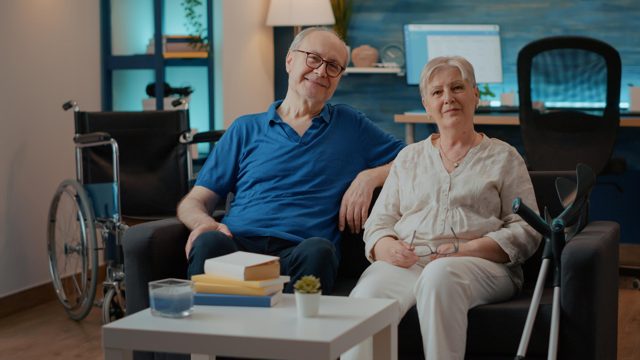Assisted Living: What it is, Paying for it, Options
The concept of assisted living is important, especially for the elderly and people with disabilities. This article delves into what assisted living is, how to fund it, and the various options available for individuals who require it.
The concept of assisted living is undeniably a vital consideration, particularly for the elderly and people with disabilities. This comprehensive exploration will peel back the layers, delving deep into the essence of assisted living. We will discuss not only what assisted living fundamentally is but also the numerous ways it can be funded and the variety of options available to cater to the diverse needs of individuals who require it. Assisted living, at its core, is about providing a supportive living environment for those who may struggle with day-to-day activities, offering them the much-needed assistance while also allowing them to maintain a degree of independence. It's a living solution that straddles the line between full-time nursing care and independent living, striving to offer the best of both worlds.

When it comes to funding assisted living, there's a myriad of options available, each with its own set of benefits and drawbacks. From long-term care insurance to reverse mortgages, personal savings, or even governmental programs, we'll delve into the details of each, helping you to navigate this often complex landscape.
Lastly, we'll explore the different types of assisted living options, ranging from small residential houses to larger, more resort-like communities. Each option offers a unique set of services and amenities, ensuring there's a fit for every individual's unique needs and lifestyle preferences. Not only will we outline these choices, but we'll also offer guidance on how to select the one that best meets your needs or those of your loved ones. In this comprehensive article, we aim to provide insightful knowledge and practical advice on assisted living, enabling you to make informed decisions that enhance quality of life and ensure the best possible care for those who need it.
What Is Assisted Living?
Assisted living provides skilled help and nursing for older people and people with disabilities in a residential setting. These facilities are designed for individuals who want some degree of independence, yet require access to assistance as needed.
Assisted living is more than just a service; it's a compassionate approach that combines skilled nursing care with a homely atmosphere for our older citizens and individuals living with disabilities. Imagine a place where you can live independently, yet have immediate access to professional care and assistance whenever you need it - that's the essence of assisted living. These facilities are meticulously designed to cater to the unique needs of each individual, while fostering a sense of community and belonging. In an assisted living facility, residents aren't just occupants - they're part of an integrated community, a family. They are surrounded by people in similar circumstances, which makes it easier for them to relate, connect, and share experiences.

This environment promotes mutual support, companionship, and, quite often, lifelong friendships. The emphasis in these facilities is on balancing independence with the right level of care.
Residents are encouraged to live as independently as they choose, with the comforting reassurance that help is always at hand. From assistance with daily tasks, such as dressing, bathing, or meal preparation, to round-the-clock medical care, the staff at assisted living facilities are committed to ensuring the well-being, safety, and happiness of every resident. In essence, assisted living is an excellent option for older individuals and those with disabilities who crave the autonomy of living alone yet need the assurance of professional help when necessary. It's a place where they can enjoy the best of both worlds: independence and tailored assistance in a safe, welcoming, and nurturing environment.
Understanding Assisted Living
Residents in an assisted living facility may stay for as little as a month or as long as necessary. The main goal is to ensure they have the right level of care and assistance while preserving their independence as much as possible.
At these residences, the length of stay can be incredibly flexible, ranging from a brief sojourn of a month to an extended period that spans several years based on individual needs and circumstances. The primary objective, however, remains constant - to provide a customized degree of care and support tailored to each resident's unique requirements. This is accomplished while simultaneously aiming to uphold their sense of autonomy and personal freedom to the greatest extent achievable. These facilities strive to create a nurturing environment where residents can feel at home. They offer various amenities and services that cater to diverse needs, thus ensuring a comfortable and worry-free living experience.

From round-the-clock healthcare services to recreational activities, the residents' welfare and happiness are at the heart of their operations. Furthermore, the philosophy behind such facilities is deeply rooted in respect for the individuality and dignity of each resident.
Therefore, the emphasis is placed not only on physical health and safety but also on emotional well-being and social engagement. By offering opportunities for interaction, learning, and entertainment, these facilities foster a sense of community and belonging among residents. In conclusion, assisted living facilities serve as a haven for those who require a certain degree of assistance in their daily lives but still wish to maintain their independence. Here, residents can enjoy a balance of care and autonomy, staying for as short or as long as necessary, all while being part of a vibrant, supportive community.
The Role of Assisted Living
Assisted living facilities are crucial for people who need help with Activities of Daily Living (ADLs). This could be due to old age, a disability or a chronic illness that makes it challenging for them to live independently.
Assisted living facilities play an incredibly vital role in society, providing much-needed support to individuals who require assistance with Activities of Daily Living (ADLs). These facilities are particularly beneficial for individuals grappling with the challenges of old age, disabilities, or chronic illnesses that render independent living a daunting task. The importance of these facilities cannot be overstated as they provide a lifeline to those who need help with basic tasks such as bathing, eating, dressing, and moving around. As age progresses, or as a disability or illness becomes more pronounced, the ability to perform these seemingly simple tasks can diminish, leading to a pressing need for professional assistance. This is where the value of assisted living facilities truly shines through.

They offer professional, compassionate care that helps individuals maintain their dignity and quality of life, even in the face of challenges that might otherwise be overwhelming. Moreover, assisted living facilities are not just about providing physical support.
They also offer a community environment where residents can interact with others in similar situations, fostering a sense of belonging and companionship that can be immensely beneficial for mental and emotional well-being. The availability of social activities, combined with the peace of mind that comes from knowing that professional help is always at hand, makes these facilities an indispensable part of our healthcare landscape. In the face of old age, disability, or chronic illness, assisted living facilities offer a beacon of hope and support, allowing individuals to live their lives to the fullest, despite their physical limitations.
Understanding Activities of Daily Living (ADLs)
Activities of Daily Living (ADLs) refer to the basic tasks that people do every day. They include eating, bathing, getting dressed, mobility, continence, and toileting.
When an individual struggles with these tasks, they might need to consider assisted living. Activities of Daily Living, often abbreviated as ADLs, encompass the everyday tasks that most of us perform without giving them a second thought. These tasks form the backbone of our day-to-day lives, providing us with a sense of normalcy and routine. They include mundane but essential activities such as eating, which is not just about the act of consuming food but also meal preparation and clean up. Bathing, another critical ADL, involves maintaining personal hygiene, which is crucial for both physical health and self-esteem. Getting dressed is another aspect of ADLs, a task that might seem simple but requires a certain degree of mobility and dexterity. Speaking of mobility, it refers to the ability to move around independently, whether it's moving from one room to another or going outside for a walk.

Continence, an often overlooked aspect of ADLs, signifies the ability to control bladder and bowel functions, a critical factor for personal dignity and comfort. Finally, toileting involves safely getting to and from the toilet, a task that requires both mobility and a certain level of physical strength.
When an individual starts struggling with these tasks, it might be a sign that they need extra help. This is where assisted living comes into the picture. Assisted living facilities are designed to provide support and assistance with these ADLs, ensuring that individuals can continue to live their lives with dignity and independence. It's not an easy decision to make, but it's an important one for those who find their daily routines becoming increasingly challenging. Therefore, understanding the role and importance of ADLs is a crucial first step in recognizing when it might be time to consider transitioning to an assisted living environment.
The 6 Key Activities of Daily Living
These activities – eating, bathing, getting dressed, mobility, continence, and toileting – are fundamental for living independently. If a person needs assistance with these tasks, they may benefit from the care provided in an assisted living facility.
Immerse yourself in the simple yet essential activities of daily life that we often take for granted - eating, bathing, getting dressed, moving freely, maintaining continence, and managing our personal hygiene through toileting. These are the very building blocks that enable us to live a life of independence, that allow us to carry out our day-to-day tasks with ease, and that affirm our ability to take care of ourselves. When we pause to think about it, these activities form the very rhythm and routine of our lives, shaping our independence and self-sufficiency, and giving us a sense of control and autonomy. However, there comes a time in everyone's life when these tasks might prove to be challenging due to various reasons such as aging, illness, or disability. During such times, carrying out these fundamental tasks can become a struggle, leading to a compromised quality of life.

It is in these moments, when assistance with these tasks becomes a necessity rather than a luxury, that a person may significantly benefit from the comprehensive care provided in an assisted living facility. Assisted living facilities are designed to bridge the gap between independent living and nursing home care.
They offer a balanced blend of support and autonomy, providing assistance with daily tasks while allowing residents to maintain their independence as much as possible. The aim is to ensure the safety, well-being, and dignity of the residents, while also promoting their physical, mental, and social health. The care provided in these facilities is personalized, respectful, and professional, making them an ideal choice for those who need some assistance with daily tasks but do not require round-the-clock medical care. Transitioning to an assisted living facility can be a positive step towards preserving one's independence, enhancing their quality of life, and ensuring they receive the right level of care and support.
Paying for Assisted Living
Funding for assisted living can come from a variety of sources, including personal savings, long-term care insurance, veterans benefits, and in some cases, Medicaid. Its important to explore all options and understand what is covered.
Securing finances for assisted living can emerge from a diverse range of resources. Personal savings is often the first port of call, where individuals dip into their hard-earned reserves to cater for their assisted living needs. This financial route is a testament to one's commitment to planning ahead and taking charge of their own future care. However, it's not the only option available. Long-term care insurance is another viable alternative, a policy designed specifically to cover the costs of long-term care services, most of which are not covered by traditional health insurance or Medicare. This can provide peace of mind and security, knowing that you have a safety net in place. Veterans benefits are also a noteworthy resource, particularly for those who have served our country.

These benefits can significantly offset the cost of assisted living, making it more accessible and affordable. It's a deserved reward for those who have dedicated a part of their lives to military service.
Lastly, Medicaid, in some instances, can provide funding for assisted living. While not universally available, in certain states and under specific conditions, this form of assistance can be a lifeline for those with limited financial means. It's crucial to thoroughly investigate all potential options and gain a comprehensive understanding of what is covered under each plan. This often involves delving into the finer details and may require consultation with financial advisors or legal experts. Understanding the implications of each funding source can prevent unexpected surprises down the line and ensure that you or your loved one can receive the care they need without undue financial stress. The process of securing funding for assisted living is not just about finding a solution, but about finding the best solution for your individual circumstances.
Understanding Assisted Living Costs
The costs of assisted living vary widely depending on the level of care required, the location of the facility, and other factors. Its crucial to get a clear picture of all costs before making a decision.
The financial commitment of assisted living can fluctuate significantly due to a broad spectrum of influencing factors. Paramount among these is the level of care a resident requires, which can range from basic assistance with daily tasks to around-the-clock medical supervision. Naturally, the more intensive the care, the higher the cost. Furthermore, the geographical location of the facility can also dramatically affect the price. A facility located in a bustling, high-demand city will likely carry heftier price tags compared to those nestled in quieter, rural regions. Moreover, additional factors come into play such as the size and type of the living space, the range of amenities offered, and whether the establishment is private or non-profit.

In light of these considerations, it becomes crucial, even indispensable, to obtain a comprehensive, transparent breakdown of all potential costs associated with a facility before making a final decision. This should include not only the basic living expenses but also any possible extra charges for services or activities that may arise.
Deciding on an assisted living facility is an important, life-changing choice. It's not just about affordability, but also about finding the right fit for you or your loved one's lifestyle, care needs, and personal preferences. Therefore, understanding the full financial implications is an essential part of this decision-making process. It’s not a step to be taken lightly, so equip yourself with all the necessary information, consider all possibilities, and make an informed decision that will ensure peace of mind and the best possible care.
Options for Assisted Living
There are several options for those who need assistance with ADLs. These include in-home care, assisted living facilities, and nursing home care.
Each option has its benefits and drawbacks, and the best choice depends on the individuals needs and circumstances. Certainly! Here's a more extensive version of your paragraph:For individuals requiring support with Activities of Daily Living (ADLs), there is a wide spectrum of choices available, each designed to cater to a unique set of needs and circumstances. Among these options, in-home care, assisted living facilities, and nursing home care stand out as the most common alternatives. In-home care, for instance, offers a highly personalized approach, allowing individuals to receive assistance within the familiarity and comfort of their own homes. It provides a sense of independence and can be tailored to meet specific needs - from meal preparation, housekeeping, personal care to medical services. However, it may be challenging for those who require round-the-clock supervision or for those who feel isolated at home. Assisted living facilities, on the other hand, provide a community setting for those who need help with ADLs but can still maintain a level of independence.

These facilities offer a blend of assistance and autonomy, with benefits such as social activities, health services, and prepared meals. The downside could be the potentially high cost, and the transition may be difficult for some.
Finally, nursing home care is designed for those who need constant, professional medical attention. The benefits include 24-hour supervision, access to skilled healthcare professionals, meals, and activities. However, it may offer less personal freedom and could also be the most expensive option. In conclusion, the decision to choose the right care option should be based on the individual’s specific needs, financial capabilities, and personal preferences. It is essential to thoroughly research, visit potential facilities if possible, and consult with healthcare professionals to ensure an informed decision is made. After all, the ultimate goal is to provide the best possible quality of life for the individual in need.
Choosing the Right Assisted Living Option
Choosing the right type of care is a personal decision that should be based on an individuals needs, lifestyle, and financial resources. Its essential to research each option thoroughly and consider getting advice from a healthcare professional.
Deciding on the appropriate care for oneself or a loved one is an intimately personal decision, one that requires careful consideration of various factors. It's not a decision to be taken lightly and should be based primarily on the individual's unique needs, preferred lifestyle, and available financial resources. This decision-making process becomes even more critical when dealing with health concerns, as the right type of care can significantly impact a person's quality of life. When considering care options, it's essential to conduct thorough research on each available choice. Investigate the pros and cons, the costs and benefits, and the overall impact on the individual's daily life. This research should not be limited to simply reading pamphlets or online reviews. Instead, it should involve reaching out to professionals in the field, visiting facilities, and speaking with those who have experienced similar situations.

Moreover, never underestimate the value of professional advice in making this crucial decision. Healthcare professionals have a wealth of knowledge, expertise, and experience that can provide invaluable insights.
They can help assess the individual's needs, advise on suitable options, and even recommend resources for financial assistance if needed. It's always beneficial to have a healthcare professional in your corner, guiding you through the process of choosing the right care. In conclusion, choosing the right type of care is a multifaceted decision. It's a delicate balance between the individual's needs, lifestyle preferences, and financial capabilities. It requires in-depth research, careful consideration, and professional advice. By taking the time to make informed decisions, you can ensure the best possible care for yourself or your loved one.
Conclusion
Understanding the basics of assisted living, how to pay for it, and the options available is the first step towards making an informed decision. Its a critical component of ensuring that individuals who need help with daily activities receive the right level of care.
Grasping the fundamental concepts of assisted living, discerning methods to finance it, and discovering the multitude of choices accessible is the initial stride on the journey towards making a well-informed, sound decision. This decision isn't just a matter of practicality; it is a cornerstone of ensuring one's dignity and quality of life in their golden years. Assisted living represents a critical component in guaranteeing that individuals who require assistance with daily activities, whether due to age or health conditions, receive the appropriate level of care tailored to their unique needs. In addition to understanding the basics, it is pivotal to delve deeper into the intricacies of this care model. This includes acknowledging the emotional and lifestyle adjustments that come with transitioning to an assisted living facility.

Equipping oneself with such knowledge can empower individuals and families to navigate this often challenging terrain with confidence and peace of mind. Furthermore, comprehending the financial aspect of assisted living is crucial.
The costs can be substantial, and understanding how to manage these expenses effectively, whether through savings, insurance, or government assistance, is an essential part of the process. Exploring all available options and making informed comparisons can lead to significant financial savings and eliminate unnecessary stress. Thus, the first step in this journey is not just about understanding the basics; it's about arming oneself with comprehensive knowledge, preparing for lifestyle changes, strategizing financial plans, and ultimately ensuring the right level of care for loved ones. This proactive approach can make this life transition smoother and more manageable, providing peace of mind for everyone involved.
About us
Welcome to SeniorCaresHub! Welcome to our comprehensive senior care destination! We pride ourselves on being a trusted resource for all things related to caring for aging loved ones. We understand the unique needs and challenges that come with senior care, and our mission is to provide you with the information, resources, and support you need to confidently navigate this journey and help you provide the best possible care for your aging loved one.

